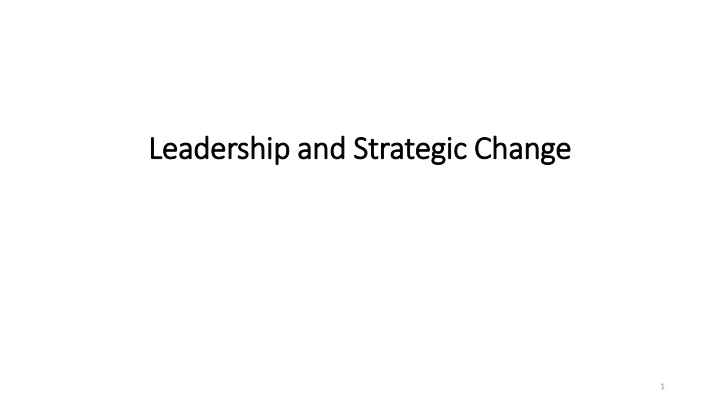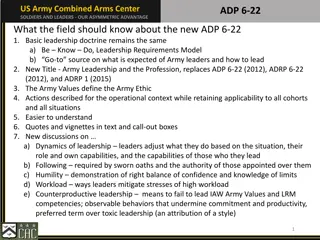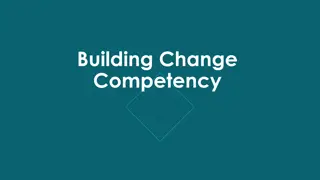Leadership and Strategic Change: Key Elements and Managing Issues
This comprehensive guide delves into the intricacies of leadership and strategic change, covering topics such as identifying types of required strategic change, analyzing organizational context influences, conducting forcefield analysis, assessing different styles of managing change, exploring key elements in managing strategic change, and diagnosing change contexts and types. The importance of strategy, context, inertia, resistance, and leadership in change management is emphasized, along with the four types of strategic change: adaptation, reconstruction, revolution, and evolution.
Download Presentation

Please find below an Image/Link to download the presentation.
The content on the website is provided AS IS for your information and personal use only. It may not be sold, licensed, or shared on other websites without obtaining consent from the author.If you encounter any issues during the download, it is possible that the publisher has removed the file from their server.
You are allowed to download the files provided on this website for personal or commercial use, subject to the condition that they are used lawfully. All files are the property of their respective owners.
The content on the website is provided AS IS for your information and personal use only. It may not be sold, licensed, or shared on other websites without obtaining consent from the author.
E N D
Presentation Transcript
Leadership and Strategic Change Leadership and Strategic Change 1
Learning outcomes (1) Identify types of required strategic change. Analyse how organisational context might affect the design of strategic change programmes. Undertake a forcefield analysis to identify forces blocking and facilitating change. 2
Learning outcomes (2) Identify and assess the different styles of leading and managing strategic change. Assess the value of different levers for strategic change. Identify the pitfalls and problems of managing change programmes. 3
Key elements in managing strategic change Diagnosis Leading and managing change Levers for change Managing change programmes 4
Managing change key issues Four key premises: Strategy matters in identifying the need for change and the direction of change. Context matters the right approach to change depends on the circumstances. Inertia and resistance getting people to change from existing ways of doing things is essential. Leadership matters good leadership of change at all levels is needed. 5
Diagnosing the change context Types of change Context of change Forcefield analysis 6
Types of strategic change Figure 14.2 Types of change Source: Adapted from J. Balogun and V. Hope Hailey, Exploring Strategic Change, 3rd edition, Prentice Hall, 2007 7
Types of strategic change Four types of strategic change: Adaptation can be accommodated with the existing culture and can occur incrementally. Reconstruction rapid change but without fundamentally changing the culture. Revolution fundamental changes in both strategy and culture. Evolution cultural change is required but this can be accomplished over time. 8
The importance of context Figure 14.3 The Change Kaleidoscope Source: Adapted from J. Balogun and V. Hope Hailey, Exploring Strategic Change, Prentice Hall, 2007 9
Forcefield analysis A forcefield analysis provides an initial view of change problems that need to be tackled by identifying forces for and against change. Various concepts and frameworks are useful here: Mapping activity systems. Stakeholder mapping. The culture web. The 7-S framework. 10
A forcefield analysis for the UK forestry commission Illustration 14.2 11
Strategic leadership roles Leadershipis the process of influencing an organisation (or group within an organisation) in its efforts towards achieving an aim or goal. Three key roles in leading strategic change: Envisioning future strategy. Aligning the organisation to deliver that strategy. Embodying change. N.B. Middle managers have a key role in leading change as well as senior managers. 12
Newcomers and outsiders Outsiders can also play an important role in strategic change. These could include: A new chief executive from outside the organisation can bring a new perspective. New management from outside can also diversity of ideas. Consultants are used to help formulate strategy or to plan the change process. increase the 13
Styles of strategic leadership Situational leadership successful strategic leaders are able to adjust their style of leadership to the context they face. Two approaches: Theory E: the pursuit of economic value; top-down; hard levers of change; emphasis on changes of structures and systems, financial incentives, portfolio changes, downsizing. Theory O: the development of organisational capability; emphasis on culture change, learning, participation in programmes and experimentation. change A combination of the two approaches may be required and can be beneficial. 14
Styles of managing change Education/ Delegation Styles of Managing Change Collaboration Participation Coercion Direction 15
Styles of managing change (1) Education and delegation Small group briefings to discuss and explain things. The aim is to gain support for change by generating understanding and commitment. Advantages Spreads support for change. Ensures a wide base of understanding. Disadvantages Takes a long time. For radical change it may not be enough to convince people of the need for change. Easy to voice support, then do nothing. 16
Styles of managing change (2) Collaboration Widespread involvement of the employees on decisions about what and how to change. Advantages Spreads not only support but ownership of change by increasing levels of involvement. Disadvantages Time-consuming. Little control over decisions made. May lead to change within existing paradigm. 17
Styles of managing change (3) Participation Involvement of employees in how to deliver the desired changes. May include limited collaboration over aspects of how to change as well as what to change. Advantages Spreads ownership and support of change, but within a more controlled framework. Easier to shape decisions. Disadvantages Can be perceived as manipulation. 18
Styles of managing change (4) Direction Change leaders make the majority of decisions about what to change and how. Use of authority to direct change. Advantages Less time-consuming. Provides a clear change of direction and focus. Disadvantages Potentially less support and commitment, and therefore proposed changes may be resisted. 19
Styles of managing change (5) Coercion Use of power to impose change. Advantages Allows for prompt action. Disadvantages Unlikely to achieve buy-in without a crisis. 20
Levers for change A compelling case for change Challenging the taken-for-granted Changing operational processes and routines Symbolic changes Power and political systems 21
Organisational rituals and change Table 14.2 Organisational rituals and change 22
Political mechanisms in organisations Table 14.3 Political mechanisms in organisations 23
Change tactics Timing: Building on an actual or perceived crisis. Exploiting windows of opportunity. Symbolic signalling of time frames. Visible short-term wins the demonstration of such wins can galvanise commitment to the wider change strategy. 24
Turnaround strategy (1) A turnaround strategy is where the emphasis is on speed of change and rapid cost reduction and/or revenue generation. 25
Turnaround strategy (2) Elements of turnaround strategies: Crisis stabilisation. Management changes. Gaining stakeholder support. Clarifying the target market(s) and core products. Financial restructuring. 26
Turnaround strategy Table 14.4Turnaround: revenue generation and cost reduction steps 27
Managing revolutionary change Managing change in such circumstances is likely to involve: Clear strategic direction. Combining rational and symbolic levers. Multiple styles of change management. Working with aspects of the existing culture. Monitoring change. 28
Managing evolutionary change Managing change as evolution involves transformational change, but implemented incrementally. This requires: An empowering organisation. Clear strategic vision. Continual change and commitment to experimentation. Identifying interim stages and targets. Use of irreversible changes. Sustained top management commitment. Winning hearts and minds. 29
Why change programmes fail Research into why change programmes fail indicates seven main failings: Death by planning. Loss of focus. Reinterpretation of change in terms of current culture. Disconnectedness. Behavioural (only) compliance. Misreading scrutiny and resistance. Broken agreements and violation of trust by management. 30
Summary (1) Types of strategic change differ in terms of: extent of culture change required; incremental change or urgency Aspects of organisational context (as shown in the Change Kaleidoscope) include: the resources and skills that need to be preserved, the degree of homogeneity or diversity in the organisation, the capability, capacity and readiness for change, the power to make change happen. Different approaches to managing change are likely according for different types of change and context. 31 31
Summary (2) Forcefield analysis is a useful means of identifying blockages to change and potential levers for change. Situational leadership suggests that strategic leaders need to adopt different styles of managing strategic change according to different contexts and in relation to the involvement and interest of different groups. Levers for managing strategic change need to be considered in terms of the type of change and context of change. Such levers include building a compelling case for change, challenging the taken-for-granted, the need to change operational processes, routines and symbols, the importance of political processes, and other change tactics. 32
Class room test Select one strategic change in your organization or any other organization and discuss what style of managing change , management applied and its repercussions. (20 Marks) 33























